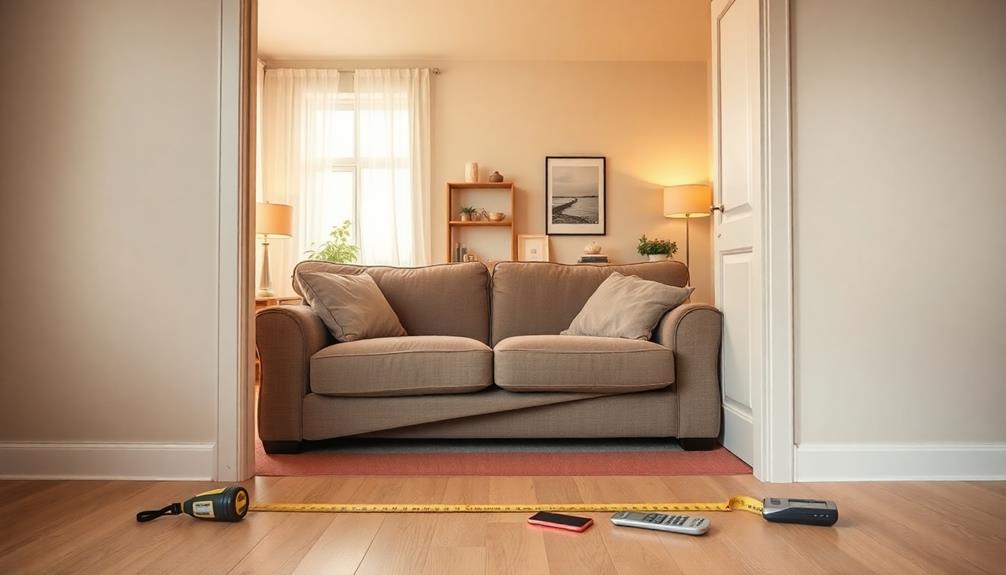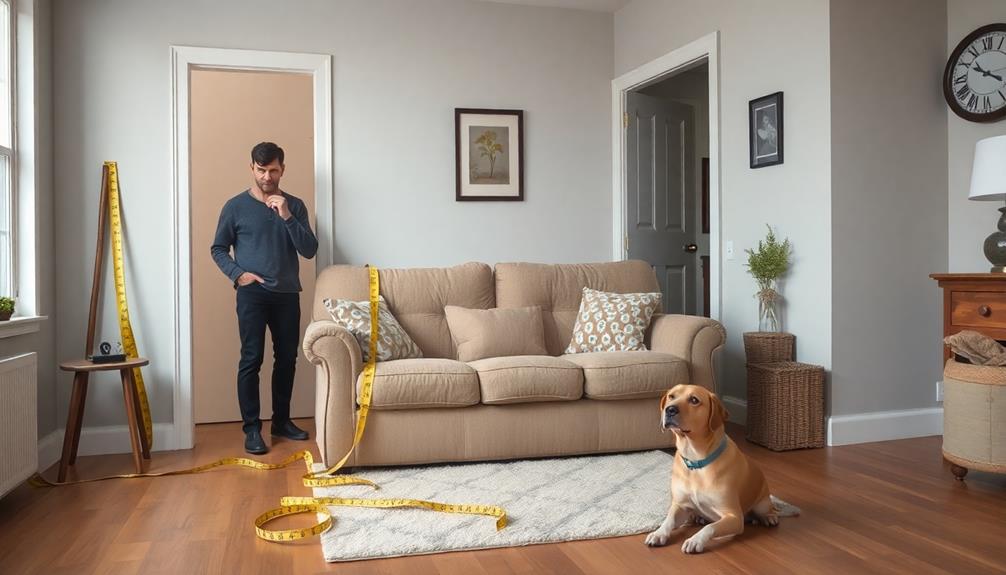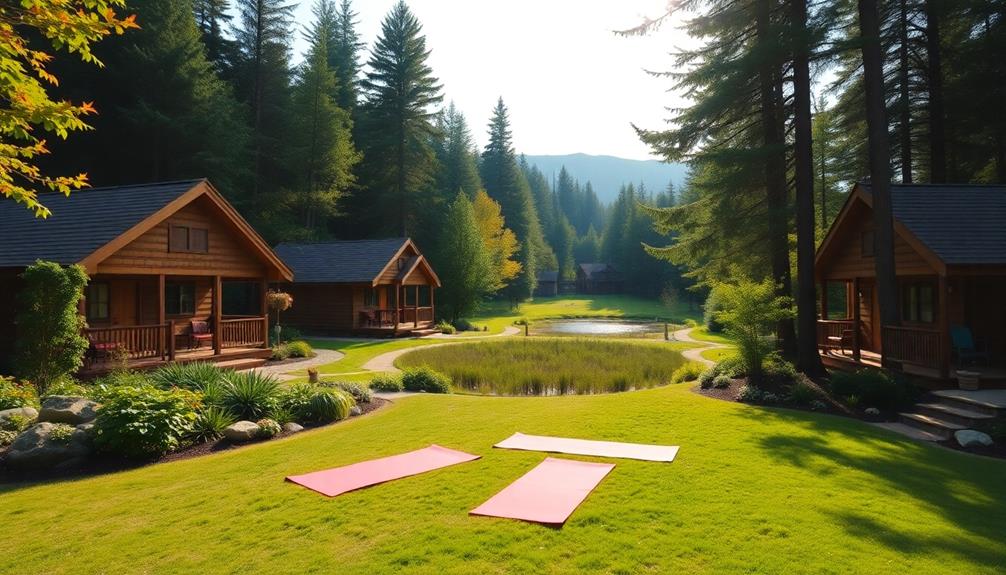To see if your sofa can squeeze through that door, start by measuring its length, width, and height, including the armrests and cushions. Next, measure the doorway's height and width, accounting for any frames and obstructions. A sofa fit calculator can help you evaluate if it'll fit; just input your measurements. Sometimes, angling the sofa or disassembling removable parts can make a difference. Remember to take into account surrounding space and obstacles. If you're still unsure, you might want to explore additional tips to guarantee a smooth moving experience.
Key Takeaways
- Measure the sofa's height, width, and depth carefully, including armrests and cushions, for accurate dimensions.
- Measure the doorway's height and width, accounting for frames and obstructions that may affect movement.
- Use a sofa fit calculator to quickly determine if the sofa will fit through the doorway.
- Consider angling the sofa or removing parts to reduce its size for easier maneuverability.
- Clear the surrounding area of obstacles to facilitate a smooth transport process during the move.
Measuring Your Sofa Dimensions

When you're preparing to move your sofa, measuring its dimensions accurately is vital. Start by grabbing a tape measure and clear the area around the sofa for unobstructed measurements.
Measure the length from the outermost points, including the armrests, and note the width from one side to the other, making sure to account for any cushions. It's also helpful to reflect on the layout of your space and any obstacles that may affect your movement.
Additionally, ensuring that your air quality is ideal during this process can make for a more pleasant environment, especially if you're dealing with dust or allergens from the move; you might want to look into air purifier maintenance dos and don'ts.
Don't forget the height, as it's important for ensuring it fits through doorways and hallways. Precision is key here; even small discrepancies can lead to fitting issues later.
Taking these accurate measurements will help you avoid unnecessary complications during your move, ensuring a smoother experience when maneuvering your sofa through tight spaces and sharp turns.
Measuring Your Doorway Dimensions

Measuring your doorway dimensions is just as essential as measuring your sofa. Start by using a tape measure to get accurate height and width.
Don't forget to include any door frames, moldings, or other obstructions that might affect clearance. Typically, doorways range from 28 to 36 inches wide, but you should double-check yours.
Additionally, understanding your budget for moving expenses can help you plan for any unexpected costs that may arise during the process.
Next, measure the depth of the doorway and any adjacent walls to identify potential obstacles. Pay attention to light fixtures or narrow hallways that could complicate the move.
Remember, tight spaces and sharp turns can pose significant challenges, so it's vital to measure everything accurately.
Taking these steps will help you avoid unnecessary headaches when moving your new sofa into your home.
Using the Sofa Fit Calculator

To guarantee your sofa fits through the doorway, you'll want to utilize the Sofa Fit Calculator effectively. Start by entering your accurate measurements for both the sofa and the doorway.
Here are some key points to remember:
- Measure the sofa's height, width, and depth carefully. Consider using essential oils like peppermint oil to refresh your mind before tackling this task.
- Account for protruding features like door frames and handles.
- Input the doorway's height and width for precise results.
- Consider angling the sofa or disassembling removable parts to ease movement.
Once you've entered the dimensions, the calculator will give you a quick yes or no answer about the fit.
This tool helps streamline your planning and reduces the risk of surprise fitting issues on moving day. Use it to make your sofa delivery as smooth as possible!
Interpreting Calculator Results

After you've entered your sofa and doorway dimensions into the Sofa Fit Calculator, you'll receive a straightforward yes or no answer regarding the fit.
If it's a yes, you can proceed with confidence, knowing your sofa should fit through the doorway.
However, if the answer is no, don't panic. This result indicates that you might need to adjust your approach. Consider measuring the diagonal length of your sofa; angling it could make a difference.
Be sure to think about any removable parts, which can help reduce overall size.
Considering Additional Factors

Even if the Sofa Fit Calculator gives you a yes, there are still several factors to contemplate before attempting to move your sofa.
Keep in mind that fitting isn't just about dimensions; other elements play a significant role:
- Weight of the sofa: Heavier pieces can be more challenging to maneuver.
- Surrounding space: Confirm there's enough room to navigate without bumping into obstacles.
- Angle of approach: Sometimes, angling the sofa helps it fit through tight spaces.
- Obstructions: Check for light fixtures, furniture, or narrow hallways that could complicate your move.
Exploring Alternative Solutions

When faced with a challenging move, exploring alternative solutions can make all the difference in getting your sofa into your home. Start by considering professional delivery services; they have experience in tricky situations. Check for removable parts on your sofa—disassembling can simplify transport.
You might also look for alternative entry points, like windows. Although maneuvering through a window can be tricky, it often provides a larger opening. Just remember to measure both the window and your sofa accurately.
| Solution | Benefits |
|---|---|
| Professional Movers | Expertise in difficult moves |
| Removable Parts | Easier transport |
| Alternative Entry Points | Larger openings |
| Disassembly | Reduced dimensions |
| Team Assistance | Safer maneuvering |
Practical Tips for Moving

Traversing tight spaces and maneuvering heavy furniture can be intimidating, but with a few practical tips, you can simplify the moving process. First, it’s important to declutter and organize your belongings before the move. This will not only make the process easier but will also create a more harmonious living space in your new home. You can also consider using feng shui tips to optimize the layout of your furniture and create a sense of balance and flow in each room. By taking these simple steps, you can alleviate some of the stress and anxiety often associated with moving and create a more seamless transition into your new living space. Another helpful tip is to consider the feng shui rule of keeping pathways clear and unobstructed. This will make it easier to navigate through tight spaces and prevent any accidents or damage to your belongings. Additionally, paying attention to the placement of mirrors and incorporating natural elements like plants can further enhance the positive energy and harmony in your new home, in accordance with feng shui principles. By incorporating these feng shui rules into your moving process, you can not only streamline the physical aspect of moving but also create a more peaceful and balanced environment in your new home.
Keep these strategies in mind:
- Measure everything: Always measure your sofa and doorway dimensions accurately.
- Disassemble when needed: Take apart removable parts of your sofa to ease transport.
- Utilize a sofa fit calculator: Input your measurements to check if the sofa will fit.
- Get help: Don't hesitate to ask friends or hire professionals for assistance.
Frequently Asked Questions
Can I Use a Sofa Cover for Protection During Moving?
Yes, you can use a sofa cover for protection during moving. It'll shield your sofa from scratches and dirt, making it easier to handle. Just make sure it fits snugly for ideal protection.
What Tools Do I Need for Disassembling My Sofa?
Did you know nearly 70% of sofas have removable legs? To disassemble your sofa, you'll need a screwdriver, Allen wrench, and possibly pliers. Always consult the manufacturer's instructions for safe and effective disassembly.
Is There a Weight Limit for the Sofa Fit Calculator?
The sofa fit calculator doesn't specify a weight limit, but it's designed primarily for dimensions. Make certain you account for the sofa's weight when planning your move, as it can impact maneuverability and fitting.
How Do I Measure a Curved Sofa for Fitting?
To measure a curved sofa, use a flexible tape measure along the curves' outer edges. Measure width at the widest point and depth from front to back. Verify you account for cushions and any removable parts.
What Should I Do if My Sofa Gets Stuck in the Doorway?
When your sofa's stuck, frustration contrasts with opportunity. Don't panic—try angling it or removing parts. If all else fails, enlist help or consider professional movers for a seamless solution, avoiding damage to both your furniture and home.
Conclusion
Bringing your new sofa home should feel like a warm embrace, not a wrestling match. By carefully measuring both your sofa and doorway, and using the Sofa Fit Calculator, you can avoid the stress of a stuck couch. Remember to factor in those tight corners and potential obstacles, and don't hesitate to explore alternative solutions if needed. With a little planning and these practical tips, you'll welcome your new piece of furniture with ease and joy.










